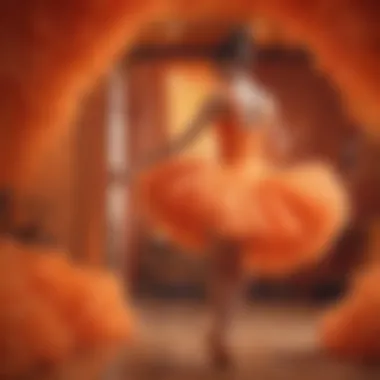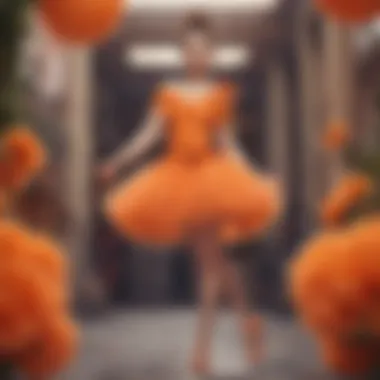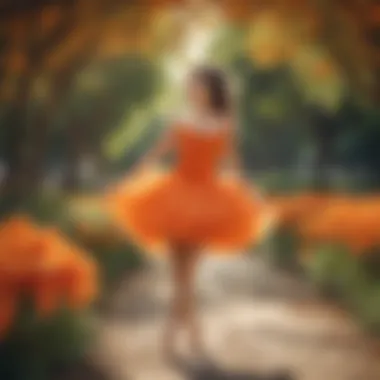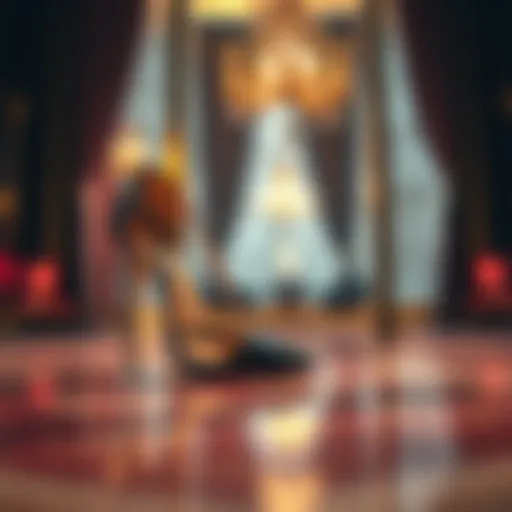Exploring the Versatile Nature of Orange Tutus


Intro
In the colorful realm of fashion, the orange tutu stands out not just as a garment but as a symbol steeped in cultural significance and artistic expression. Whether seen twirling in a ballet class or integrated into eclectic streetwear, orange tutus provoke a spectrum of responses—from playful to provocative. This exploration dives into their historical roots, construction nuances, and versatile styling options. Here, we’ll uncover the layers of meaning nestled within this vibrant fabric, and the implications it holds for modern day styling and sustainability.
Fashion Insights
Current Trends in Clothing
The world of fashion is continually in flux, and orange tutus, with their lively hue, are finding their place amidst these trends. In recent years, there has been a shift towards embracing bold colors, and orange, with its sunny antics, fits right in. Designers are no longer afraid to experiment with shades that stand out. From runways to retail shops, tutus in various styles have emerged as a favored choice, breaking away from the traditional confines of ballet wear.
- Layering: Many stylists are opting to layer tutus with oversized jackets or graphic tees, bringing an unexpected edge to femininity.
- Rock-Chic Aesthetic: Pairing an orange tutu with combat boots has become increasingly popular, marking a fusion of delicate and tough elements that speaks volumes about individual expression.
- Mixing Textures: Designers are also playing with textures—think tulle mingling with leather or denim—to create a contradiction that intrigues the eye.
Iconic Fashion Moments
Orange tutus have also found their way into memorable fashion moments that have left a lasting mark on the industry. Take for example the iconic performance by ballet dancers such as Misty Copeland, who not only challenges traditional views of ballerinas but also redefines beauty norms within the dance world. Her vibrant orange tutu in pivotal performances sent ripples through the fashion scene, showcasing how a simple garment can morph into a powerhouse of cultural dialogue.
In addition, renowned fashion houses have showcased tutus in their collections that cater to avant-garde aesthetics. The scenes with celebrities donning orange tutus at high-profile events suggest an intriguing exploration of femininity, freedom, and self-expression, encapsulating everything from sophistication to rebellion.
"Fashion is about collaboration and expression, and an orange tutu can easily dance to the beat of any style."
Practical Style Tips
Building a Versatile Wardrobe
Integrating an orange tutu into your wardrobe may initially seem daunting. However, flexibility is key. Here are practical ideas:
- Casual Ensemble: Pair your tutu with a simple white tee and sneakers for a laid-back outing.
- Dress it Up: For a more upscale event, match your tutu with a fitted blouse and heels; adding statement jewelry can elevate the look further.
- Seasonal Adaptation: In cooler months, wear the tutu over tights or under a long coat to keep warm while still looking chic.
Sustainable Fashion Choices
Given the growing concerns surrounding sustainability, it’s crucial to consider fabric choices and construction techniques when choosing tutus. Opt for designers using eco-friendly materials or those advocating fair trade practices. Some notable points to think about include:
- Materiality: Natural fabrics, like organic cotton or recycled polyester, can reduce environmental impact.
- Local Artisans: Supporting local designers not only backs the community but often results in more ethical production practices.
- Second-Hand Options: Vintage shops or resale platforms can be treasure troves for unique tutus, reducing waste while still letting you rock an orange tutu in your own unique way.
Exploring the vibrant world of orange tutus offers a window into more than just fashion. It's an invitation to embrace creativity, challenge norms, and engage with the principles of sustainability, making this seemingly simple garment a multifaceted marvel.
Preamble to Orange Tutus
The realm of orange tutus is not merely a fashion statement; it’s a captivating exploration into artistic expression, cultural significance, and timeless design. Tutus, in their vibrant orange form, exemplify versatility, appealing to dancers, fashion enthusiasts, and beyond. They ignite a spark of creativity, drawing attention not just for their appearance but also for the emotions tied to their color.
Definition and Characteristics
Orange tutus are often defined by their unique cut and structure, which can range from soft, layered fluffiness to structured, dramatic designs. Generally made of tulle or other lightweight materials, their primary characteristics include:
- Color: Orange, a hue that symbolizes enthusiasm and warmth.
- Structure: Different styles, like the classic ballerina tutu, can be layered or single-tiered.
- Length: Varies from knee-length to floor-length, offering diverse styling options.
The fabric choice often impacts the overall look; sheer tulle provides a soft silhouette, while stiffer fabrics can create angular shapes that stand out during performances. The uniqueness of the orange tutu lies in its ability to evoke different sentiments depending on the context – whether it's lighthearted fun or a deep emotional performance.
Historical Context of Tutus
The tutu has a storied past that dates back to the 19th century, initially serving as part of a ballet dancer's costume. The orange variant, while not as historically prevalent, has gained traction in modern interpretations of dance and fashion. Historically, tutus were primarily seen in classical ballet, characterized by restricted movement and strict form. However, as dance evolved, so did tutu styles.
The evolution of the orange tutu can be seen as a reflection of broader cultural shifts:
- 19th Century Ballet: Tutus were predominantly white or pastel, denoting purity and grace.
- Modern Dance Influence: A surge in bold colors like orange emerged in the late 20th century to reflect a new wave of artistic expression.
- Cultural Symbolism: Orange, often associated with celebration and creativity, gradually found its place in various dance genres, including contemporary and jazz.


In summary, understanding the historical context of tutus enriches the appreciation for the orange tutu. It showcases not just how fashion evolves, but also how it resonates with cultural narratives and artistic impulses. Thus, the orange tutu is not merely a garment; it embodies a fusion of tradition with contemporary creativity.
Cultural Significance of the Color Orange
The color orange, vibrant and warm, has long been associated with a range of meanings across different cultures. In the context of orange tutus, understanding this significance is much more than a mere exploration of aesthetics. The color influences perceptions, shapes experiences, and evokes emotions, all of which can be intertwined with fashion and individual expression.
Orange is often viewed as an energetic color. Its brightness captures attention and embodies enthusiasm. For various cultures, it symbolizes warmth, creativity, and vitality. In many Asian cultures, for instance, orange represents happiness and good fortune. In China, the color is believed to bring prosperity, making it popular in celebratory decorations and attire.
In Western societies, orange can signify adventure, curiosity, and a zest for life. This makes it a fitting hue for tutus, which are typically associated with playful freedom and artistic expression. This section aims to unravel the intricate web of meanings tied to orange, especially as it pertains to fashion, creativity, and individual expression through garments like tutus.
Symbolism in Various Cultures
The rich tapestry of orange's symbolism across cultures adds another layer of depth to the understanding of orange tutus:
- Spiritual Significance: In Hinduism, saffron, a shade of orange, signifies purity and is often worn by monks and spiritual leaders. This connection reflects a quest for enlightenment and truth.
- Festivities and Celebration: In many cultures, including Mexico, orange is a color found in celebrations such as Day of the Dead, where marigolds (often orange) are used to honor the deceased. The color represents the connection between the living and the dead, infusing personal remembrance with joy and vibrancy.
- Harvest and Abundance: The association of orange with the harvest further accentuates its role in celebrations like Thanksgiving in the U.S., where pumpkins—a rich source of orange—symbolize abundance.
Through these lenses, orange tutus channel rich cultural narratives. When worn, they carry with them the traditions and emotional resonances of the experiences behind the color. This not only adds to the garment's aesthetic appeal but also to its storytelling potential.
The Psychological Impact of Orange
Beyond its cultural implications, orange has a unique psychological impact. It’s a color that can provoke lively feelings and decisive actions, often instilling a sense of excitement and vitality:
- Stimulating Creativity: Many creatives gravitate toward orange for its ability to inspire. It can evoke playful imagination and spur innovative thoughts, making it an excellent choice for costumes, performances, and, of course, tutus.
- Encouraging Social Interaction: Studies suggest that orange can encourage communication and interaction among individuals. Festivals, dance recitals, or social gatherings featuring orange tutus may foster connections and expressions of joy, enhancing communal experiences.
- Creating Warmth: The warmth of orange can be inviting. When seen in fashion, it often elicits cheerful and positive feelings. This warmth contributes to a sense of belonging and comfort, which can be particularly important in dance contexts where expression is essential.
To sum up, the color orange serves as a bridge connecting human emotions, cultural narratives, and individual expression through garments like tutus. It reflects an exuberance that has the potential to transform a simple outfit into a vibrant statement.
Acknowledging these aspects shapes a fuller understanding of how orange tutus are not just a fashion choice but a canvas for cultural expression and emotional resonance.
Crafting the Perfect Orange Tutu
Creating an orange tutu goes beyond just picking a bright color; it's about understanding the nuances that make this garment not only visually appealing but also functional. Crafting a tutu correctly can elevate the experience of wearing one, whether it’s for dance, a costume party, or just everyday casual wear. Some might think it’s just a fluffy garment, but it’s the careful consideration of materials and styles that brings an orange tutu to life.
Materials Used
The choice of materials can significantly impact everything from the overall aesthetic to comfort levels. Not all fabrics are made alike, and selecting the right ones ensures the tutu maintains its shape while being soft enough to wear. Here are a few common materials:
- Tulle: A lightweight, net-like fabric that creates that iconic fluffy silhouette. It's commonly used in multiple layers to give volume, making it essential for any tutu design.
- Satin: Adds a splash of shine and a more luxurious feel. Often used for linings or accents, satin can make an orange tutu both eye-catching and comfortable.
- Cotton: Some tutus incorporate cotton to offer breathability. For warmer days, cotton blends can provide relief, though they may lack the structural integrity of tulle.
- Organza: Similar to tulle but stiffer, organza provides structure and can help create a more dramatic shape.
When creating or purchasing an orange tutu, think carefully about which materials resonate with your intended use. The right blend can enhance both the form and function of the tutu, creating an outfit that feels as good as it looks.
Creating Different Tutu Styles
A tutu is more than just a fluffy garment; it's a versatile piece that can be tailored to fit various occasions and personal styles. Here are some distinct styles:
Classic Ballerina Tutu
The classic ballerina tutu often conjures images of grand performances and elegance. This style features multiple layers of tulle that are meticulously arranged to form a bell-like silhouette. What stands out in this design is its structure, making it a preferred choice for ballet dancers.
- Key Characteristic: Its stiffened layers allow for precise movements, making it a staple for ballet performances.
- Unique Feature: Often paired with bodices and worn with tights, you can frequently see this style in dance recitals and performances, giving it a timeless elegance.
While it oftentimes is a stunning choice, it can be less practical for everyday wear due to its elaborate nature.
Short Poodle Tutu
For those looking for something playful and fun, the short poodle tutu offers a lively alternative. This style is characterized by its shorter length and is typically worn at hip-height.
- Key Characteristic: The silhouette is undeniably cute, with a lively bounce that compliments a variety of casual outfits.
- Unique Feature: This style is typically layered with fewer tiers of material, making it easy to wear in warmer weather.


Its versatility makes it a favorite for casual outings, but it may not provide the same dramatic effect on stage as its classic counterpart.
Long Dramatic Tutu
If one aims to make an entrance, the long dramatic tutu guarantees an unforgettable impression. This style flows to the floor and boasts layers that enhance movement, making it a fabulous choice for formal occasions or themed events.
- Key Characteristic: The cascading effect of the fabric adds an element of grace, perfect for showcasing a dancer's movements or making a statement at events.
- Unique Feature: Length can range to be floor-sweeping, which often gives off a fairy-tale vibe.
While it offers a striking visual impact, those wearing a long dramatic tutu may find it requires more careful navigation, especially in crowded spaces.
The choice of style not only reflects personal taste, but also the intended occasion and comfort, making each tutu unique in its own right.
In exploring the art of crafting an orange tutu, understanding these materials and styles are pivotal. This knowledge enables an individualized expression, tapping into the vibrant possibilities that the color orange has to offer.
Styling Orange Tutus
Styling orange tutus involves more than merely placing a vibrant garment on one’s body; it encompasses a full breadth of creative potential that can dramatically influence how a person presents themselves to the world. The ability to mix, match, and accessorize a tutu according to the occasion allows for a unique expression of individuality while also showcasing the versatile appeal of this playful silhouette. This section will delve into the various ways to style orange tutus, catering both to the rustic charm of casual wear and the opulent ambiance of formal events.
Casual Looks with Tutus
When contemplating casual looks, orange tutus ooze a charming spirit that can brighten even the cloudiest day. Here are some elements that pair beautifully with an orange tutu for a laid-back vibe:
- Graphic Tee: Pairing an orange tutu with a simple white graphic tee can offer a whimsical touch while keeping it grounded. The tee can be knotted at the waist for added flair.
- Denim Jacket: A casual denim jacket can add layers and create a harmonious juxtaposition with the light, airy feel of a tutu. This combo works well for cooler evenings without sacrificing style.
- Sneakers: A pair of vibrant sneakers can create a playful look that’s easy to walk around in. Opt for a color that complements the orange, like navy or purple, to tie the outfit together.
- Casual Accessories: Consider adding a canvas tote bag or a simple cap to round out the outfit, ensuring the vibe remains fun and carefree.
In essence, casual styling allows for the expression of personal taste without the constraints of formal fashion norms. The lightheartedness of an orange tutu can serve as a standout element in an otherwise casual ensemble.
Formal Occasions Featuring Tutus
Contrary to the belief that tutus belong solely on stages, they can indeed make their mark at formal gatherings. Here’s how to elevate an orange tutu for more sophisticated occasions:
- Chic Blouse: Choose a fitted, elegant blouse to balance the volume of the tutu. Soft pastels or even metallic shades can create a striking contrast that draws attention.
- Statement Belt: A well-placed statement belt helps to define the waist and adds an element of elegance, transforming the overall silhouette into something refined.
- Heeled Shoes: For a touch of sophistication, opt for strappy heels or classic pumps that elevate the outfit, literally and figuratively. This choice also adds grace to the movement when wearing the tutu.
- Minimalist Jewelry: Select delicate earrings or a thin bracelet to keep the focus on the tutu while also enhancing the outfit’s elegance.
In an era of evolving fashion, wearing an orange tutu to a formal occasion can shatter the traditional dress codes. It stands as a bold statement of creativity and newfound norms, marking a shift in how we perceive and wear such garments.
"Fashion is about experimenting with combinations. The orange tutu might just be the surprising burst of creativity that every formal event needs."
Styling an orange tutu, whether casually or formally, beckons for an imaginative approach. The key is to play with contrasts and complements, allowing the tutu to shine while making moments memorable.
Tutus in the Dance World
Tutus have long been a symbol of grace and artistry within the realm of dance. They serve not only as a costume but also as an essential conduit for expressing the dancer's movements and emotions. In this section, we will explore the pivotal role that orange tutus play, diving into their significance in ballet and contemporary dance. By understanding these contexts, one can appreciate how vibrant orange adds a layer of depth to the performance itself.
Tutus in Ballet Performances
Ballet is perhaps the most recognized domain for tutus, where they have become a staple costume element. Traditionally, ballet tutus are structured to accentuate the dancer's lines and figures, showcasing the intricate motions of their choreography. An orange tutu, with its eye-catching hue, stands out brilliantly against the stage backdrop, allowing the performer to command attention.
The tutu’s design, with layers of tulle and netting, creates an illusion of weightlessness, making even the simplest movements mesmerizing. For instance, as a dancer executes a pirouette, the fabric swirls around them, creating a visual spectacle. The choice of orange often symbolizes enthusiasm and creativity; thus, when dancers don these vibrant tutus, they convey a message of warmth and energy to their audience.
Despite their beauty, the technical aspects of performance cannot be overlooked. Different ballet performances often call for distinct styles of tutus – the classical ballet tutu, characterized by its form-fitting bodice and short, stiff skirt, allows for freedom of movement. In contrast, longer, more flowy styles might be utilized for dramatic storytelling pieces, adding layers of storytelling through movement. In this way, the choices dancers and choreographers make around tutu design are crucial to effectively conveying the narrative of their performances.
Tutus in Contemporary Dance
Shifting gears to contemporary dance, the use of tutus takes on a different but equally fascinating role. Unlike the rigid structures in classical ballet, contemporary dance embraces fluidity and innovation. Here, the orange tutu can serve as a creative expression, reflecting the themes or emotions depicted in the performance.
Dancers may choose tutus that are less structured, favoring softer materials that allow for a wider range of motion and spontaneity. The color orange in this context can signify a connection to the earth or evoke feelings of vibrancy and life. Choreographers often play with contrasts, such as pairing an orange tutu with a black background, to striking effect. The clashing colors fuel the emotional resonance of the dance, capturing the audience’s attention.
When it comes to performances, the manner in which an orange tutu interacts with movement can create stunning visual poems. A dancer spinning might appear like a flame, flickering in the air, as the flowing fabric catches the light. This synergy between costumes and choreography not only amplifies the dance itself but allows the dancers to assert their individuality through style.


"The dancer’s body is the canvas, and the tutu is the paint, transforming each movement into a work of art."
In both ballet and contemporary dance, the orange tutu ultimately proves to be more than just fabric. It embodies the essence of performance, while highlighting the passion behind each dance. With such rich symbolism and versatility, these tutus are essential to the art of dance, challenging conventions and inviting audiences into a vibrant, emotional experience.
Trends Influencing Orange Tutu Designs
The world of fashion is continually evolving, with trends playing a pivotal role in shaping designs. When it comes to orange tutus, several key influences forge the landscape of their aesthetics and practicality. By understanding these trends, designers and fashion enthusiasts can appreciate how the vibrant hue interacts with current styles, caters to customer demands, and fosters individual expression.
The Role of Social Media
In today’s digital age, social media is a colossal player in fashion trends. Platforms such as Instagram and TikTok serve as catwalks for amateur and professional designers alike, showcasing their creations to a global audience almost instantaneously. Orange tutus, once seen primarily in the realm of classical ballet, have found new life through social media influencers. They promote various ways to wear them, transforming a traditional garment into a canvas for intimate self-expression.
- Visual Storytelling: By sharing images and videos featuring orange tutus, users create compelling narratives around this vibrant garment. Influencers often showcase different styling options, from laid-back casual looks to more extravagant ensembles, thus broadening their appeal.
- Hashtag Culture: Platforms abound with hashtags like #OrangeTutu, giving designers and users visibility, fostering community discussions, and sparking inspiration. This sense of community surrounding tutus encourages creatives to experiment with colors and styles, while also drawing market interest.
- Fashion Weeks and Events: Traditionally exclusive events such as New York Fashion Week have found their conversations amplified by social media. Trends like orange tutus pop up as highlights, gaining attention from wider audiences and influencing mainstream fashion.
Fashion Icons and Their Impact
Fashion icons have an undeniable influence over contemporary trends, often serving as the bellwethers for what becomes popular. When celebrated figures sport orange tutus, it sends ripples throughout the fashion world. Their artistic interpretations inspire designers and fashionistas alike, encouraging the incorporation of this lively color into new designs.
- Runway Showcases: Designers who integrate orange tutus into their collections can trigger a frenzy of interest. For instance, a high-profile fashion show featuring a striking orange tutu can lead to an explosion of similar designs seen across various retailers.
- Celebrity Influence: Celebrities like Lady Gaga or Solange Knowles might showcase orange tutus as part of their signature style, prompting fans to emulate their looks. This imitation can elevate trends from niche to mainstream practically overnight.
- Collaborations: Iconic partnerships between designers and influencers often spotlight orange tutus in their collections, continuously refreshing their appeal. These partnerships pave the way for new generations to connect with this vibrant garment, bridging history and contemporary style.
The interplay between social media, fashion influencers, and emerging trends shapes the orange tutu's presence in modern fashion. As people increasingly look for ways to express their individuality while embracing sustainable practices, understanding these trends empowers them in making informed, stylish choices.
Tutus and Sustainability
Sustainability is not merely a buzzword in today’s fashion climate; it has become a critical focus for designers and consumers alike. Within the realm of tutus, particularly those spotlighting the vivid hue of orange, sustainability plays a pivotal role. This section explores how eco-conscious choices can reshape the way we view and utilize this iconic garment.
The fashion industry, for years, has been criticized for its excessive waste and reliance on unsustainable materials. As stylists, designers, and fashion influencers embrace sustainability, the push for eco-friendly alternatives is gaining momentum, leading to a cleaner planet and more responsible wardrobes.
Eco-Friendly Materials
When diving into the world of orange tutus, the materials used can either enhance or undermine the idea of sustainability. Traditional tutus often rely on synthetic fabrics like polyester, which, while economical, contribute significantly to environmental degradation. So, what are the alternative, eco-friendly materials that can be harnessed?
- Organic Cotton: Grown without harmful pesticides, organic cotton provides a softer touch while being gentle to the earth. It's breathable and perfect for dance rehearsals or casual outings.
- Recycled Polyester: Rather than creating more waste, recycled polyester repurposes plastic bottles and other materials. This not only reduces landfill waste but also saves resources used in the manufacturing of new textiles.
- Tencel: Derived from sustainably sourced wood pulp, Tencel adds a luxurious feel to tutus. It's biodegradable and produced in a closed-loop system, minimizing water and chemical use.
- Bamboo Fabric: Bamboo grows rapidly and requires little water, making it a sustainable option. Its antibacterial properties keep tutus fresher for longer wear.
By choosing these materials when crafting orange tutus, consumers and designers alike can contribute to a more sustainable future without sacrificing style or comfort.
Responsible Manufacturing Practices
The production process of tutus also plays a crucial role in achieving sustainability. Responsible manufacturing practices can significantly reduce the carbon footprint associated with the fashion industry. Here are some key considerations:
- Fair Labor Practices: Ensuring that workers involved in the production of tutus are treated ethically and paid fairly is paramount. This responsibility fosters community well-being and supports sustainable development.
- Local Production: Sourcing materials and manufacturing locally can greatly reduce transportation emissions. Supporting local artisans not only benefits the environment but also strengthens local economies.
- Zero-Waste Patterns: Some designers are adopting zero-waste practices by creating tutu patterns that utilize fabric without leaving any scraps. This innovation minimizes waste significantly during production.
- Energy Efficiency: Utilizing renewable energy sources in production facilities helps to reduce reliance on fossil fuels. Practices such as using solar panels or wind energy promote a greener manufacturing process.
Implementing these practices ensures that the creation of orange tutus does not come at the expense of the environment or ethical standards. The industry is slowly but surely changing, but conscious consumerism must continue to grow alongside it.
"Sustainable fashion is not just a trend; it is the future of clothing. By embracing eco-friendly materials and responsible manufacturing, we pave the path for a healthier planet."
As the conversation around sustainability grows within the fashion community, orange tutus stand as a vibrant symbol of change. Through eco-conscious choices in materials and practices, this attention-grabbing garment can help make a significant impact on our world's environmental challenges.
Ending: Embracing the Orange Tutu
The conversation surrounding orange tutus is not just about fashion; it encapsulates personal expression, creativity, and a nod to sustainability. In this article, we have peeled back the layers of this vibrant garment, revealing much more than its colorful exterior. Embracing an orange tutu signifies the willingness to showcase one’s individuality while participating in a cultural dialogue that spans history and ongoing trends.
Personal Expression Through Fashion
To many, the choice of an orange tutu can represent boldness and flair. It’s about making a statement without uttering a single word. Whether adorned in classic ballerina style or mixed with streetwear, the tutu invites a playful engagement with fashion conventions. This specific color can uplift moods and inspire confidence, creating a visual spectacle that engages audiences and wearers alike.
Using an orange tutu can even feel like a form of wearable art; it allows a breadth of interpretation by the observer. Some view it as fun and whimsical, while others see a deeper resonance with cultural philosophies and artistic movements. This duality makes the orange tutu a powerful tool for personal self-expression.
The Future of Tutus in Fashion
As we gaze into the future, it’s apparent that tutus—especially in vibrant hues like orange—are here to stay. The intersection of fashion and sustainability is reshaping how garments are made and marketed. Designers are increasingly creating exclusive collections with eco-conscious materials and methods, paving the way for orange tutus crafted from organic cotton and reclaimed fabrics.
Moreover, the influence of social media cannot be ignored. Platforms help spread the vibrant allure of orange tutus far and wide, showcasing unique styles among influencers and everyday fashion enthusiasts. As a result, we might witness a surge in diverse interpretations of how the tutu is worn, blending traditional ideas with contemporary angst.
"Fashion is not just about clothes. It's about creativity and a sense of who you are. In tutus, particularly orange ones, this sense shines brightly."
In summary, embracing the orange tutu signifies more than just choosing a colorful garment. It denotes participation in a multidimensional narrative of art, culture, and self-identity. As we navigate the evolving fashion landscape, the orange tutu stands as a testament to the vibrancy of personal style and the importance of sustainable practices in fashion.







